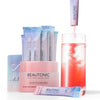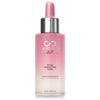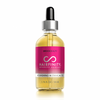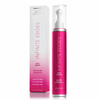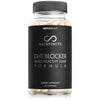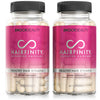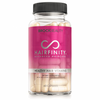
Chlorine Hair: How to Protect Your Locks After Swimming

Now summer is in full swing, it’s time to hit the pool. But you’ll have to do more than stock up on sunblock if you want to stay healthy this summer: chlorine and other pool chemicals can wreak havoc on your hair – especially if you’ve recently had your hair colored or straightened.
Don’t let chlorine damage ruin your summer. We’ve got everything you need to know about how to protect your hair before – and after – swimming in the pool:
Chlorine Woes
When you’re seeking relief from the summer heat, it’s tempting to just go for a swim. But before you head to the pool, it’s important to understand why chlorine can cause such major problems for your hair.
A relatively harsh chemical, chlorine is great for killing bacteria in pools – but terrible for delicate tresses. Not only does it sap hair of moisture, but the chemical reaction also causes major fading or discoloration.
Yikes.
Don’t let your hair fall victim to chlorine or other harsh chemicals – be proactive, so your hair stays soft, moisturized, and protected all summer long.
Before You Jump
To make sure your hair is well-protected from potential chlorine damage, take a few precautionary steps this summer.
1. ALL ABOARD WITH OILS
A moisturizing oil treatment, like coconut oil or olive oil, can help seal the hair follicle, making it more difficult for chlorine to penetrate and cause damage.
Just remember to add a swimmer’s cap, suggests stylist Scott Fontana.
“You have to use oil on the hair before going into the pool, as anything else will rinse right out once you hit the water,” Fontana told StyleCaster.
“However, you have to keep your head covered, as oil will also cook your hair in the hot sun.”
Since both coconut and olive oil are also great deep conditioners, this treatment has the added benefit of moisturizing strands that have fallen victim to summer heat and dryness.

2. CAP IT OFF
From a ponytail or loose bun to an old-school swim cap, protective styling can provide you with the coverage you need to keep chlorine at bay.
This is an especially crucial step for women who dye their hair in the summer, says Schwarzkopf brand ambassador Kim Vo.
“Try to keep your head and hair out of the water as much as possible,” Vo told Glamour.
“A cute bun, topknot, or braid prevents your strands from soaking in the pool water while you float around and wade.”
Braids and buns aren’t the only form of protection you’ll need.
Used to only applying sunscreen to your skin? You may want to extend your hair and scalp the same courtesy before you jump in the pool.
SPF can minimize the effects of chlorine damage in your hair and protect your scalp, too. Because it so often goes untreated or uncovered, the scalp is one of the areas on your body most prone to getting uncomfortable sunburns.
A lightweight spray with SPF is often all it takes to get the coverage you need to keep your hair and scalp happy.
3. COLD RINSE
One of the most important steps to take before you go for a swim in a chlorinated pool is to rinse off in the shower first. This might seem counterintuitive, but your hair will thank you for it.
Just be sure to rinse – not shampoo, emphasizes stylist Adir Abergel.
Shampooing “strips away your protective oils, leaving hair vulnerable to drying chemicals and salt,” Abergel told Health.
A cool rinse should get you all ready to show off your best swan dive into the deep end.

Out of the Pool
Now that you’ve got your pre-swim routine down pat, it’s time to reverse the process. These may put a few extra steps between you and your beach towel, but they’re well worth the protections they offer:
1. RINSE – AND REPEAT
That’s right – even though you hopped in a cool shower before jumping in the deep end, you have to head straight back to the locker room.
“For happy hair throughout summer, your best bet is to rinse hair with fresh water immediately after getting out of the pool or ocean,” explains Annie Crawford at Bustle.
“Chlorine sitting on your hair all day and baking in the sun is surefire disaster for blondes or anyone with chemical damage,” she added.
Not only can pool chemicals turn blonde or light-colored hair a ghoulish green, but they can also wreak havoc on chemically treated hair – which is porous and delicate.
Ever wondered why light-colored hair turns green?
According to InStyle, that green hue occurs when chlorine “enters your hair shaft and leaves behind traces of copper, which then oxidize and cause your strands to shift toward the chartreuse end of the spectrum.”
So, pretty please: put a quick shower at the top of your to-do list as soon as you get out of the pool. (Yes, it’s got to rank higher than scoping out the lifeguard stand.)

2. CLARIFYING SHAMPOO
If swimming laps is a big part of your summer, you may find that you’ve attracted chlorine deposits – those pesky chemical bonds we mentioned earlier.
Try a clarifying shampoo, or an apple cider vinegar rinse, to help re-set your hair.
“It’s cost-effective to use apple cider vinegar, which acts as a natural clarifier,” suggests Lee at Health. “Just add one part vinegar to four parts water and pour it over freshly washed hair.”
This should remove any chlorine or copper deposits – and eliminate the risk of your hair turning green. But beware – the one-two punch of chlorine and clarifying treatments will dry out your locks.
Using a leave-in conditioner after cleansing can help restore lost moisture and keep your hair soft – and strong – all summer long.
3. STYLE WITH CARE
Spending a lot of time in the pool might make you re-arrange your calendar. For example, if you have an appointment to touch up your color or straighten your hair – stay far away from the pool that afternoon.
“If you don’t rinse, you can cause a chemical reaction,” celebrity colorist Frederic States told StyleCaster.
“I’ve seen hair fall out as a result of the chemical reaction, and it’s not pretty,” he added.
The risk of long-term damage may make going natural for the summer worthwhile, says dermatologist Jessica Krant. That means no color, no straightening – and no heat styling.
“This will keep the hair cuticle as smooth as possible, which helps the hair shaft to resist penetration by harsh chlorine and greenifying copper,” Krant explained to Fitness.
Can’t hack it? Remember to use a protective styling spray or cream, so your tresses can withstand the extra heat.
Don’t let dryness, damage, and that dreaded green hue haunt your vacation photos.
Whether you’re planning on swimming laps or just staying cool, it’s crucial to take extra steps to protect your hair from chlorine damage this summer.
Take the time to rinse and use conditioning treatments for softer, healthier hair, so you can actually relax once you’ve reapplied sunscreen and set your towel in the shade.






